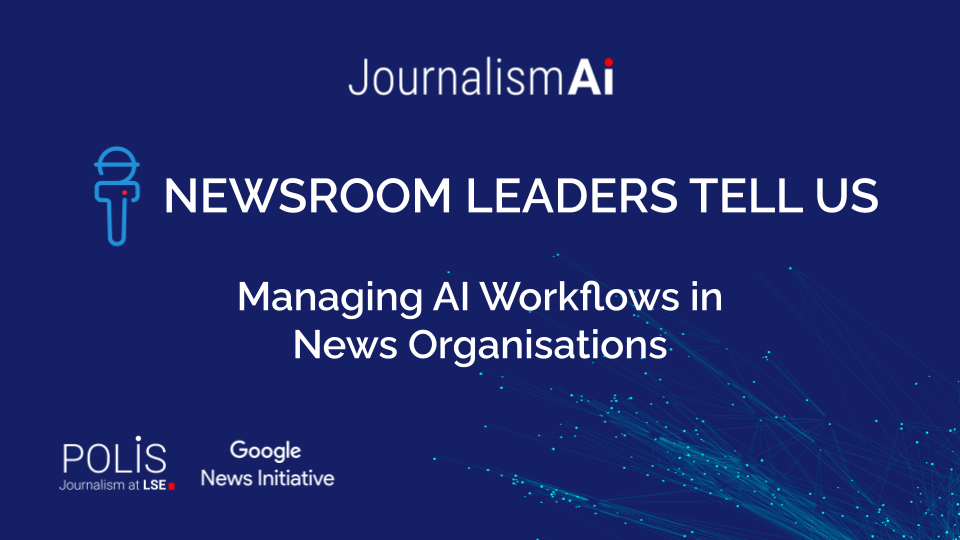During the Festival that JournalismAI hosted in December 2020, Alyssa Zeisler – R&D Chief and Product Lead for Editorial Tools at The Wall Street Journal in New York – and Anna Vissens – Lead Data Scientist at The Guardian in London – talked with Jane Barrett – Global Editor for Media News Strategy at Reuters – about how technology and AI have a big role in defining new roles in newsrooms and how to forge new ways of integrating AI solutions in the newsroom.
Key Takeaways
- AI-powered tools can help journalists do better work with better information, without removing their wisdom from the equation.
- Building such tools requires interdisciplinary teams of engineers, designers, business developers, data scientists, and journalists.
- Working with AI in a newsroom requires a good combination of technical knowledge and soft skills such as versatility, emotional intelligence, and interpretation.
- The career tracks of Anna and Alyssa demonstrate the importance of taking initiative. Both of them identified some challenges and sought to solve them in creative ways, whilst making use of their respective skills.
“We’re naturally nervous of a machine or a vaccine only being X-percent correct and trustworthy, but if we actually measured our own decisions every day, we’ll find that our level of accuracy is often considerably lower”
Jane Barret, Reuters
Getting started in AI-Journalism
A physicist by trade, Anna worked for an insurance company for years, then switched careers and started working as a journalist. Later on, missing academia and the sciences, she realised she could combine her passion for journalism and sciences within the newsroom with projects that implement data and analytics.
The biggest problem Alyssa noticed at the beginning of her career in the media industry was a lack of consumer focus in the newsroom. She started using data to help the newsroom make data-informed decisions that could lead to new editorial products. Her growing interest in innovation then brought her to R&D.
Although Anna and Alyssa work in two different countries with different journalistic cultures, their goals are similar: They want to help journalists do better work with the help of data, analytics, and AI-powered tools. As Anna explained, we shouldn’t fear AI as the “robot taking away people’s jobs”. While they might take away some tasks from journalists, these new technologies are also creating new jobs and opportunities. Those refusing to adapt and embrace these technologies might lose out. Both Anna and Alyssa believe that the more data-informed newsrooms become, the less scary data will look to people.
Day-to-day, both Anna’s and Alyssa’s teams work closely with reporters, editors, engineering teams, and product managers. When bringing technology into journalism, each idea becomes a collaborative effort. But a shiny new tool that works well during its testing phase might not yield the same outcomes when adopted at scale. As a result, implementing an idea can sometimes open up a challenging process, which is why input from different teams is essential. If everyone is on the same page, it is much easier to deliver solutions.
How journalists and AI can collaborate
AI-powered tools are not meant to replace human oversight. They merely help journalists with certain repetitive and time-consuming tasks so that they can focus on the creative part of the job. In Anna’s experience, editors and journalists are open to incorporating more automation, especially when it makes their work easier to do and doesn’t remove their expertise from the equation.
At The Wall Street Journal, one of Alyssa’s team’s objectives is to have more assisted production in the newsroom. She believes that computers can provide answers to the “What” questions, while reporters can freely work on answering the “Why” questions. For example, the structured data can create a draft of an article or a prompt or an alert, and in this way save time so that reporters can excel at what they’re really good at, which is creating context, analysis and links between topics and stories.
AI tools must be reviewed continuously and be subject to feedback from the users, so that they can be improved over time. Giving people in the newsroom this oversight and control helps these tools work even better.
Additional resources
- Creating a pipeline for emerging technology in the newsroom, a JournalismAI interview with Alyssa Zeisler
- The science of data in action: Changing our lives and our journalism, a JournalismAI interview with Anna Vissens
- How might we leverage the power of AI to understand, identify and mitigate newsroom biases?, a collaborative project that Jane Barrett contributed to as part of the 2020 JournalismAI Collab
This article was written by Alice B. Weiss, POLIS intern and LSE’s MSc student, and edited by Sabrina Argoub, JournalismAI Community Coordinator.
The article includes the main takeaways from one of the sessions of the 2020 JournalismAI Festival. You can watch all the Festival recordings on YouTube.
JournalismAI is a project of POLIS and it’s powered by the Google News Initiative.






